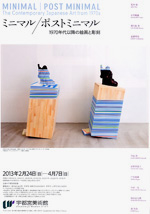 |
Picks is a monthly sampling of Japan's art scene, offering commentary by a variety of reviewers about exhibitions at museums and galleries in recent weeks, with an emphasis on contemporary art by young artists. |
 |
 |
|
|
 |
 |
 |
 |
| MINIMAL / POST MINIMAL |
| 24 February - 7 April 2013 |
Utsunomiya Museum of Art
(Tochigi) |
 |
| Bringing together the works of such artists as Kosai Hori, Toeko Tatsuno, Kazumi Nakamura, Shigeo Toya, and Toshikatsu Endo, this is among other things a tour-de-force effort by museum director Arata Tani, who made his debut as a critic in the 1970s. Efficiently arranging the artists by period, Tani does a masterful job of summarizing the minimalist and post-minimalist movements of the seventies, eighties, and nineties in Japan. |
|
 |
|

|
 |
 |
 |
|
JR: Could art change the world? |
| 10 February - 2 June 2013 |
Watari-um
(Tokyo) |
 |
| JR is a French street artist known for posting huge photo-portraits of people on outdoor surfaces -- staircases, billboards, rows of houses, building facades. The show covers his past work in Europe and the Mideast and culminates in a series of 400 photos he took over the past year and a half of residents of the disaster-stricken areas of northeastern Japan. |
|
|
 |
 |
|
Cross Sections: Chronicle @ MoMAK 1963-2013 |
|
|
The National Museum of Modern Art, Kyoto
(Kyoto) |
 |
| The museum celebrates its 50th anniversary by showcasing the craftworks that form the core of its collection. The focus is on the diversity and expressiveness of crafts as art. Part I highlights Japanese traditions, East-West cross-pollination, and design-related issues, while Part II presents a selection of masterpieces from the overall collection. |
|
|
|
|
|
|
|

|
 |
 |
|
|
|
|
|
 |
 |
 |
|
|
Emiko Aoki: Whispering Hope
|
|
12 January - 3 February 2013
|
Gallery Forgotten Dreams
(Tokyo) |
 |
| Aoki is best known for paintings in which she covers most of the canvas with swaths of vermilion over a base of globular, bubble-like shapes. In this solo show she introduced some blue-green works as well. As with the red pieces, the cluster of "objects" at the bottom of the frame creates a landscape-like impression. The blue-green, however, makes the picture plane recede further, even more intensely conjuring up landscapes -- or seascapes -- or perhaps a world under water. |
|
|
|
|
|
|
 |
 |
|
| Kazuna Taguchi and Tadasuke Iwanaga: The Crimson Sun |
| 26 January - 2 February 2013 |
ShugoArts
(Tokyo) |
 |
| Two artists with utterly disparate styles collaborated on this joint show. Taguchi takes photographs of monochrome portraits she has painted, themselves based on photographs, thus blurring the line between the two media, while Iwanaga does bold, colorful, semi-abstract paintings in which brushstrokes figure prominently. This reviewer assumed that the artists would divide the gallery space between them, but instead they jumbled their presentations together. Even more surprisingly, the jumble seemed entirely natural. |
|
 |
 |
 |
|
| Ken Sasaki: These/foolish/things |
| 26 January - 23 February 2013 |
AOYAMA | MEGURO
(Tokyo) |
 |
| At the center of this solo show were five still-life paintings of a yellow-green tennis ball imprinted with the domestic Bridgestone brand. Like yoga -- Western-style Japanese painting -- tennis is a Western import that the Japanese have made their own. Also presented were paintings of an enlarged railway route map and a chart depicting the history of modern Japanese art. In this way Sasaki takes "art-like" objects that are familiar to us and seeks to transform them into "art" through the process of painting them as they are. |
|
|
|
|
 |
|
|
 |
|